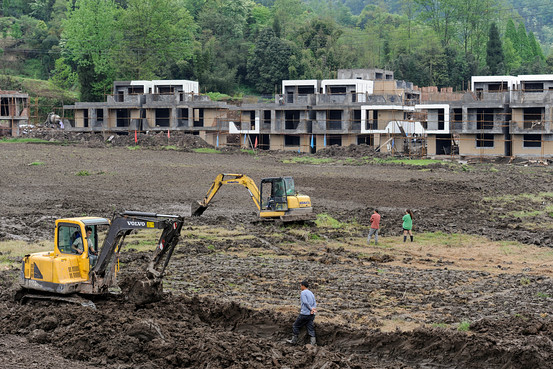Home -> News -> Media -> Land Sales: The Ever-More Lucrative Habit China’s Officials Just Can’t Kick
Land Sales: The Ever-More Lucrative Habit China’s Officials Just Can’t Kick

Local governments in China are growing ever more addicted to revenue from land sales.
That’s the takeaway from China’s Ministry of Land and Resources, which issued its second-ever annual report on land resources in China this week.
According to the report, last year, local government officials sold 367,000 hectares of land, up 14% from the year before. The sales were a bonanza for local government finances, raising 4.2 trillion yuan ($682 billion), a 56% increase over the previous year.
By contrast in 2012, governments sold 322,800 hectares, representing only a 3% rise over the previous year. That year, the 2.7 trillion yuan raised by sales was up a comparatively less dramatic 15% from 2011. (The Ministry’s annual reports don’t provide data on earlier years.)
Meanwhile, the government also made significantly more land available for residential and commercial purposes last year, up 20% and 28%, respectively. Sales of both kinds of land are significantly more lucrative than, say, land used for infrastructure construction and land used for industry, mining and warehousing, two other categories mentioned in the report. The amount of land set aside for infrastructure fell by 6% in 2013, while the land for industry, mining and warehousing only increased by around 1%.
That’s a marked change. In previous years, the government tended to emphasize land for infrastructure more, setting aside 338,500 hectares of such land in 2012, a more than fivefold increase over what was dedicated to such use in 2008. During that same period, land for industry, mining and warehousing use increased 123%, compared with only 85% for residential land.
At the time, the hope was that construction of more industrial parks and infrastructure would attract investment. But for many cities, such dreams haven’t materialized. Instead, the result is densely packed city-centers surrounded by sprawling suburbs left to stray dogs and tumbleweed.
According to a recent report by the World Bank, if Shenzhen had the same urban density as Seoul, it could accommodate an additional 5.3 million residents.
Now, it appears, local governments are finding that lucrative residential and commercial land sales are a quicker way to make a buck. But such appetite—and the prospect of even more people being forced off their land—is worrisome to the central government, which wants to ensure the country remains agriculturally self-sufficient.
In years past, local governments were responsible for giving the go-ahead for converting agricultural land to, say, residential or industrial use. But in 2013, the central government took the lead, perhaps in an attempt to guard against mindless construction by local governments as they seek to boost growth. Last year, the central government kept a tighter rein on the country’s agricultural land: the amount approved for conversion that year was the lowest since 2008.
But given that this is China, the size was still considerable: Last year, more than half a million hectares of agricultural land were approved for construction and industrial use. While that’s less than it was in previous years, it also means that China’s cities will—for the moment anyway—continue to sprawl.
- .U.S. Treasury looks to hold more cash to deal with future crises
- .Yum, McDonald's in Shanghai food safety investigation
- .Yellen defends loose Fed policy, says job market still too weak
- .Carl Icahn says 'time to be cautious' on U.S. stocks
- .Samsung Electronics says second quarter profit likely down 24.5 percent; worst in two years
- .U.S. jobs data seen reinforcing strong growth outlook
- .Asia stocks up on buoyant Wall Street, oil near highs

